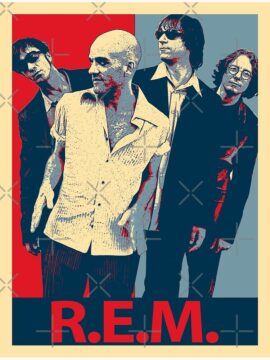Mina Tavakoli at The Yale Review:
 Not since the muzak corporation has there been an institution that soundtracks drugstores, supermarkets, and shopping malls more readily than R.E.M. After monstrous airplay across the past three decades, one imagines even the most oblivious listener well-equipped to at least passively recognize the distinct jangle of the band’s biggest hits. Perhaps you can hum the chorus of “Man on the Moon” because of the sheer number of times it has blared in your local food court. You might have heard “Shiny Happy People” while standing in the pharmacy line or “It’s the End of the World as We Know It (and I Feel Fine)” in the produce aisle, and chances are very good that “Everybody Hurts” has haunted airport bathrooms near you.
Not since the muzak corporation has there been an institution that soundtracks drugstores, supermarkets, and shopping malls more readily than R.E.M. After monstrous airplay across the past three decades, one imagines even the most oblivious listener well-equipped to at least passively recognize the distinct jangle of the band’s biggest hits. Perhaps you can hum the chorus of “Man on the Moon” because of the sheer number of times it has blared in your local food court. You might have heard “Shiny Happy People” while standing in the pharmacy line or “It’s the End of the World as We Know It (and I Feel Fine)” in the produce aisle, and chances are very good that “Everybody Hurts” has haunted airport bathrooms near you.
This might feel like a mundane—if not outright rude or odd—legacy for any band, much less one that helped define the genre we still call “alternative.” R.E.M., so often cited as a lodestar for some of the more idiosyncratic guitar-wielding white men of the last few decades (Kurt Cobain, Stephen Malkmus, Thom Yorke) and once so handsomely knighted by the tastemakers of its time (Rolling Stone dubbed it “America’s Best Rock & Roll Band” in a 1987 cover story), seemed, for a long while, like a watershed in the history of countercultural music. But if it once was (or still is) alternative, one might then ask: Alternative to what?
More here.
Enjoying the content on 3QD? Help keep us going by donating now.
